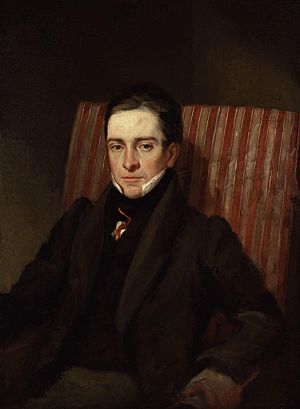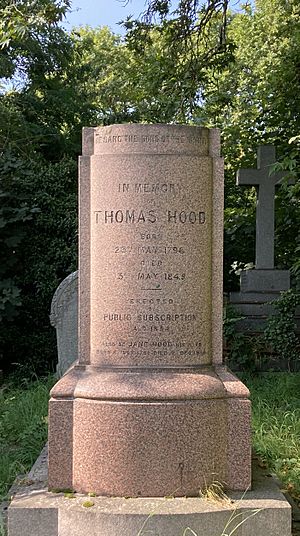Thomas Hood facts for kids
Quick facts for kids
Thomas Hood
|
|
|---|---|
 |
|
| Born | 23 May 1799 London, England |
| Died | 3 May 1845 (aged 45) London, England |
| Occupation | poet, author |
| Nationality | British |
| Period | 1820s–1840s |
| Genre | Poetry, fiction |
| Spouse | Jane Hood (née Reynolds) |
| Children | Tom Hood Frances Freeling Broderip |
Thomas Hood (born May 23, 1799 – died May 3, 1845) was a famous English poet, writer, and humorist. He is best known for his powerful poems like "The Bridge of Sighs" and "The Song of the Shirt".
Hood wrote for many popular magazines of his time, including The London Magazine and Punch. He even started his own magazine later on. Thomas Hood was not very strong and became ill when he was 41. He passed away at 45 years old. A writer named William Michael Rossetti once called him "the finest English poet" between two other great poets, Shelley and Tennyson. Thomas Hood's children, Tom Hood and Frances Freeling Broderip, also became writers.
Contents
Early Life and Learning

Thomas Hood was born in London, above his father's bookshop. His family came from Scotland. His father was a partner in a book-selling business. Thomas Hood's son, Tom Hood, said that his grandfather was one of the first to trade books with America.
When his father died in 1811, Hood's mother moved to Islington. There, he had a schoolmaster who helped him love learning. This teacher made learning fun. Hood even earned his first money by helping to edit a new book called Paul and Virginia.
At 14, Hood left school and started working in a friend's office. He found this job boring and it made his health worse. So, he began to study engraving, which is a way of making pictures by carving designs onto metal or wood. He studied with his uncle, Robert Sands, and also with the Le Keux brothers, who were famous engravers.
However, engraving was also hard on his health. Because of this, Hood was sent to live with his relatives in Dundee, Scotland. He stayed there for several months. In Dundee, he made good friends and spent time outdoors. He also read many books and started writing poetry seriously. His first published writing was a letter to a local newspaper.
Joining Literary Society
When he returned to London in 1818, Hood continued with engraving. This skill later helped him create funny drawings for his own stories and poems.
In 1821, the editor of The London Magazine died. Friends of Hood took over the magazine and asked him to be the assistant editor. This job helped him meet many important writers of the time. He became friends with people like Charles Lamb, Thomas de Quincey, and John Clare. Being around these writers helped him become a better poet and humorist.
Family Life and Works
Thomas Hood married Jane Reynolds on May 5, 1824. They had a daughter, Frances Freeling Broderip (born 1830), and a son, Tom Hood (born 1835). Both of his children followed in his footsteps. Frances became a children's writer, and Tom became a humorist and playwright. They later worked together to publish their father's writings.
Even though they often worried about money and Hood's health, the family was very loving. Their letters, published in Memorials of Thomas Hood (1860), show how much they cared for each other.
Hood's first book, Odes and Addresses, was written with his brother-in-law, John Hamilton Reynolds. Another famous poet, Samuel Taylor Coleridge, even thought the book was written by Charles Lamb because it was so good! Hood also wrote a serious poetry book called The Plea of the Midsummer Fairies (1827). But people mostly knew him for his funny writing, so this serious book was largely ignored.
Hood loved playing jokes on his family. His daughter wrote about a time he told his wife, Jane, not to buy fish with red spots because it meant they were spoiled. When a fish seller came, Jane refused to buy the fish with red spots, not knowing that red spots are natural for plaice fish!
From 1830, Hood started publishing The Comic Annual. This was a popular type of book at the time. He filled it with funny cartoons and writings about daily events. He also used many puns, which are jokes using words that have more than one meaning. As he wrote more, his style became simpler and clearer.
Later Years and Famous Poems
Hood later started his own magazine. He often worked on it from his sick-bed, as his health was getting worse. It was during this time that he wrote some of his most famous poems.
One of these was "The Song of the Shirt". This poem appeared in the Christmas issue of Punch in 1843. It became very popular and was even reprinted in other newspapers across Europe. It told the sad story of a poor seamstress (a woman who sews clothes) struggling to survive. The poem was so powerful that it inspired people to help working women who lived in poverty.
Other famous poems from this period include "The Bridge of Sighs" and "The Song of the Labourer". These poems showed the difficult lives of ordinary people. They were published shortly before Hood passed away in May 1845.
Thomas Hood was a regular writer for the Athenaeum magazine. Because of his long illness, he faced financial difficulties. Friends asked the Prime Minister, Sir Robert Peel, to give Hood a special payment for writers. Peel admired Hood's work and helped his family. After Hood's death, his wife Jane also received a pension. When Jane died, the pension continued for their two children, Frances and Tom.
Years later, a monument was built for Thomas Hood in Kensal Green Cemetery. It was paid for by public donations.
The writer William Makepeace Thackeray, who was Hood's friend, described him as a person with great courage, honesty, and patience, who always did his duty despite pain. He said Hood was a pure and devoted family man.
The house where Thomas Hood died, at 28 Finchley Road in St John's Wood, now has a special blue plaque to remember him.
Examples of His Works
Thomas Hood often wrote humorously about serious topics of his time. For example, he wrote about grave robbing, which was a real problem. People would dig up bodies to sell them for medical study. Hood wrote about this in a funny, yet dark, way:
Don't go to weep upon my grave,
And think that there I be.
They haven't left an atom there
Of my anatomie.
He also wrote a poem called "No!" about the gloomy month of November in London, which is often cool, cloudy, and foggy:
No sun—no moon!
No morn—no noon—
No dawn—no dusk—no proper time of day—
No sky—no earthly view—
No distance looking blue—
No road—no street—no "t'other side the way"—
No end to any Row—
No indications where the Crescents go—
No top to any steeple—
No recognitions of familiar people—
No courtesies for showing 'em—
No knowing 'em!—
No travelling at all—no locomotion,
No inkling of the way—no notion—
"No go"—by land or ocean—
No mail—no post—
No news from any foreign coast—
No Park—no Ring—no afternoon gentility—
No company—no nobility—
No warmth, no cheerfulness, no healthful ease,
No comfortable feel in any member—
No shade, no shine, no butterflies, no bees,
No fruits, no flowers, no leaves, no birds,—
November!
Here is a part of his famous and thoughtful poem, "I Remember, I Remember":
I remember, I remember
The house where I was born,
The little window where the sun
Came peeping in at morn;
He never came a wink too soon
Nor brought too long a day;
But now, I often wish the night
Had borne my breath away.
I remember, I remember
The roses, red and white,
The violets, and the lily-cups
Those flowers made of light!
The lilacs where the robin built,
And where my brother set
The laburnum on his birth-day,
The tree is living yet!
I remember, I remember
Where I used to swing,
And thought the air must rush as fresh
To swallows on the wing;
My spirit flew in feathers then
That is so heavy now,
And summer pools could hardly cool
The fever on my brow.
I remember, I remember
The fir trees dark and high;
I used to think their slender tops
Were close against the sky:
It was childish ignorance,
But now 'tis little joy
To know I'm farther off from Heaven
Than when I was a boy.
His most famous work during his lifetime was "The Song of the Shirt". This poem was a sad song for a London seamstress. She was forced to sell shirts she made, even though the money belonged to her boss, just to feed her sick child. This poem appeared in Punch in 1843 and became a huge hit. It was even turned into a popular song and helped inspire people to fight for better conditions for poor working women. Here is a part of it:
With fingers weary and worn,
With eyelids heavy and red,
A woman sat, in unwomanly rags,
Plying her needle and thread--
Stitch! stitch! stitch!
In poverty, hunger, and dirt,
And still with a voice of dolorous pitch
She sang the "Song of the Shirt."
"Work! work! work!
While the cock is crowing aloof!
And work—work—work,
Till the stars shine through the roof!
It's Oh! to be a slave
Along with the barbarous Turk,
Where woman has never a soul to save,
If this is Christian work!"
More of His Books
Here are some of the books Thomas Hood published:
- Odes and Addresses to Great People (1825)
- Whims and Oddities (two parts, 1826 and 1827)
- The Plea of the Midsummer Fairies, hero and Leander, Lycus the Centaur and other Poems (1827) – his only collection of serious poems
- The Epping Hunt (1829) – with drawings by George Cruikshank
- The Dream of Eugene Aram, the Murderer (1831)
- Tylney Hall, a novel (1834)
- The Comic Annual (1830–1842)
- Hood's Own, or, Laughter from Year to Year (1838)
- Up the Rhine (1840)
- Hood's Magazine and Comic Miscellany (1844–1848)
- National Tales (1837) – a collection of short stories
- Whimsicalities (1844) – with drawings by John Leech
- He also wrote many articles for other magazines.
See also
 In Spanish: Thomas Hood para niños
In Spanish: Thomas Hood para niños




